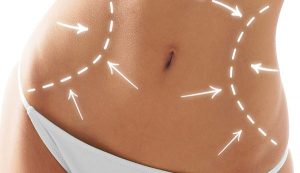Tummy Tuck

Tummy Tuck
Preparatory phase for tummy tuck
• During the period preceding the tummy tuck, surgeons usually request their patients to follow certain recommendations. If you are a regular smoker, you will be asked to refrain from smoking in the four weeks ahead of the procedure and for two weeks afterwards. Your body should not be exposed to sunlight in this period. If you are using vitamin E and aspirin, you need to stop these temporarily, in addition avoiding any crash dieting. Other health issues, such as a cold or some other infection, may result in the postponement of the procedure.
What is a tummy tuck?
• COMPLETE TUMMY TUCK (ABDOMINOPLASTY)
• PARTIAL TUMMY TUCK (MINI-ABDOMINOPLASTY)
• Abdominoplasty involves the removal of excess saggy skin and fat from the middle and lower abdomen in order to tighten the muscle and fascia of the abdominal wall. The surgery should not be viewed as a treatment for being overweight. Fat patients should lose as much weight as possible prior to the procedure. As a result of a tummy tuck, the appearance of a fat belly and abdomen is dramatically improved, however the incision is permanent. There are a number of techniques employed by plastic surgeons for abdominoplasty. A tummy tuck can be combined with other cosmetic procedures aiming to restore body contours,such as cosmetic breast procedures, liposuction, etc. Or other functional operations,such as gynaecological surgery. If you are considering a tummy tuck,this text will only provide you with introductory information and you may not find answers to all of your questions.
Where does the surgery take place?
• Complete or partial abdominoplasty is carried out at a proper hospital.
How is the surgery planned?
• At the first consultation the surgeon will examine the patient’s overall health, amount of fat around the abdomen and its distribution, level of sagging and extent of surplus in abdominal skin and its quality. The patient should accurately inform the surgeon in detail about prior or existing health conditions (such as diabetes), habits (smoking or alcohol addiction) and medications (aspirin,sedatives). The patient should also explain clearly why she desires to have this procedure made and what she expects as a result.This aspect should be discussed frankly. As a consequence of the expectations discussed and findings made during the initial consultation, the decision will taken to perform a standalone complete or partial abdominoplasty or a tummy tuck combined with a liposuction. The surgeon may conclude that liposuction alone will be sufficient and effective. During this consultation,the type of anacosmetic to be used,hospitalisation period and post-operative problems should also be discussed.
What type of anacosmetic is used?
• The majority of surgeons in Turkey prefer to use a general anacosmetic for this type of procedure. A small number may employ local anacosmetic together with painkillers and sedative drugs.
How is the surgery performed?
• A complete abdominoplasty may last two to five hours,depending on the scope of the procedure, whereas a partial tummy tuck takes one to two hours. An incision is often made from hip to hip, which can be disguised within a swimsuit, while another incision line extends around the belly. In partial abdominoplasty the incision line is shorter and there may be no need to relocate the navel. During the procedure the abdominal skin is freed from the underlying muscles from the groin to the ribs. The excess skin is removed from the body and in the event a weakness or hernia exists in the abdominal muscles, this is repaired. These procedures are more restricted in partial abdominoplasty. Subsequent to performance of surgery the wound is either closed with metal clamps or intradermic sutures, and is then covered with a dressing. In order to be able to collect the excess fluid,one or two drains may be inserted under the skin.
What to expect after surgery?
• For the first few days swelling may occur around the abdomen in addition to pain, which might be contained using painkillers. Drains are removed within the first one to three days,whereas sutures are removed within one to three weeks.Patient require hospitalisation for on average one to three days.It might take several months for a full recovery. However,the patient can return towork after two to four weeks. The scar may appear to be lessening in the first three to six months;it may take nine to twelve months for the incision to turn pale and become less visible. Although it will not disappear completely,the incision may easily be disguised within a swimming costume. Partial or complete abdominoplasty yields truly favourable results for patients with weak abdominal muscles or saggy skin.In the majority of patients,the outcome of the procedure can be preserved for years through regular exercise and a healthy diet.
What are the alternatives?
• If the patient has a tight skin of a high quality with limited fat accumulation and the abdominal wall is sound,removal of fat via vacuum suction may be considered an alternative for people of a normal weight. Diet and exercise might help reduce total body fat,however this will have little effect on the saggy skin. Unexpected post-operative implications, that is, risks or complications,are also associated with alternative treatment methods.
What are the risks?
• Hundreds of abdominoplasty procedures are performed every year. In the event a tummy tuck is performed by a plastic surgeon specialised in body contouring, the result is usually satisfactory. A certain degree of risk is associated with every surgical procedure; hence, it is important that the patient fully comprehends this aspect. While approving a surgery, the patient should be able to compare the risks and benefits of a tummy tuck. Although most patients do not encounter the following complications, they should discuss the relevant risks, possible implications and results with the surgeon until they are fully satisfied by the answers. Thanks to thorough pre-surgical consultation and assessment, complications such as infection and bleeding are rarely encountered in a tummy tuck performed by a plastic surgeon under proper hospital conditions. Infections can be treated with antibiotics,while abscesses are drained;however, this might lead to longer hospitalisation periods. Delays in wound recovery or negative wound recovery may occur, resulting in additional scarring. Under such circumstances a second surgical intervention may be required. Patients who regularly smoke are more prone to suffer from loss of skin and complications in wound recovery.
What are the long-term effects?
• Depending on aging, pregnancy and changes in body weight, the body contour beyond the area operated upon might display changes.
Could the outcome be dissatisfactory?
• The outcome of a surgical intervention rarely disappoints. An additional surgical intervention may be required to correct these undesired results. The information contained in this text may not prove to adequate for a patient. Thus, she should see a surgeon and discuss all the details in order to be informed about the process.
